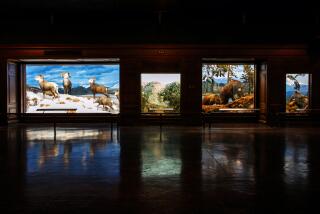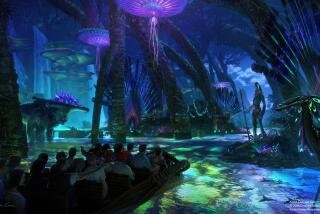Adam, Eve and T. Rex
- Share via
CABAZON, Calif. — Dinny the roadside dinosaur has found religion.
The 45-foot-high concrete apatosaurus has towered over Interstate 10 near Palm Springs for nearly three decades as a kitschy prehistoric pit stop for tourists.
Now he is the star of a renovated attraction that disputes the fact that dinosaurs died off millions of years before humans first walked the planet.
Dinny’s new owners, pointing to the Book of Genesis, contend that most dinosaurs arrived on Earth the same day as Adam and Eve, some 6,000 years ago, and later marched two by two onto Noah’s Ark. The gift shop at the attraction, called the Cabazon Dinosaurs, sells toy dinosaurs whose labels warn, “Don’t swallow it! The fossil record does not support evolution.”
The Cabazon Dinosaurs join at least half a dozen other roadside attractions nationwide that use the giant reptiles’ popularity in seeking to win converts to creationism. And more are on the way.
“We’re putting evolutionists on notice: We’re taking the dinosaurs back,” said Ken Ham, president of Answers in Genesis, a Christian group building a $25-million creationist museum in Petersburg, Ky., that’s already overrun with model sauropods and velociraptors.
“They’re used to teach people that there’s no God, and they’re used to brainwash people,” he said. “Evolutionists get very upset when we use dinosaurs. That’s their star.”
The nation’s top paleontologists find the creation theory preposterous and say children are being misled by dinosaur exhibits that take the Jurassic out of “Jurassic Park.”
“Dinosaurs lived in the Garden of Eden, and Noah’s Ark? Give me a break,” said Kevin Padian, curator at the University of California Museum of Paleontology in Berkeley and president of National Center for Science Education, an Oakland group that supports teaching evolution. “For them, ‘The Flintstones’ is a documentary.”
Tyrannosaurus rex and his gigantic brethren find themselves on both sides of the nation’s renewed debate over the Earth’s origins and the continuing fight over whether Charles Darwin’s “The Origin of Species” or Genesis best explains the development of life.
Science holds that dinosaurs were the Earth’s royalty for about 160 million years. Their reign ended abruptly, possibly after a meteorite smacked into the planet, but they’re considered the forebears of birds.
Unearthing dinosaur bones that are millions of years old “doesn’t prove evolution, but it shows the Genesis account doesn’t work,” said Nick Matzke, a spokesman for the National Center for Science Education.
Drivers who pull off Interstate 10 in Pensacola, Fla., are told a far different story at Dinosaur Adventure Land. Its slogan: “Where Dinosaurs and the Bible meet!”
The nearly 7-acre museum, low-tech theme park and science center embodies its founder’s belief that God created the world in six days. The dinosaurs, even super carnivores such as T. rex, dined as vegetarians in the Garden of Eden until Adam and Eve sinned -- and only then did they feast on other creatures, according to the Christian-based young-Earth theory.
About 4,500 years after Adam and Eve arrived, the theory goes, pairs of baby dinosaurs huddled in Noah’s Ark, and a colossal flood drowned the rest and scattered their fossils. The ark-borne animals repopulated the planet -- meaning that folk tales about fire-breathing beasts are accounts of humans battling dinosaurs, who still roamed the planet.
Kids romping through the $1.5-million Florida theme park can bounce on a “Long Neck Liftasaurus” swing seat; launch water balloons at a T. rex and a stegosaurus, and smooth their own sandbox-size Grand Canyons, whose formation is credited to the flood. A “fossilized” pickle purports to show that dinosaur bones could have hardened quickly. Got an upcoming birthday? Dinosaur Adventure Land does pizza parties.
“Go to Disneyland, they teach evolution. It’s subtle; signs that say, ‘Millions of years ago’ ” said evangelist Kent Hovind, the park’s founder. “This is a golden opportunity to get our point across.”
Carl Baugh opened his Creation Evidence Museum in the 1980s near Dinosaur Valley State Park in Glen Rose, Texas, where some people said fossilized dinosaur tracks and human footprints crisscrossed contemporaneously. The Texas museum sponsors a continuing hunt for living pterodactyls in Papua New Guinea. Baugh said five colleagues have spotted the flying dinosaurs, “but all the sightings were made after dark, and we were not able to capture the creatures.”
Organizers at Creation Research of the North Coast in Humboldt County, Calif., dream of building their own reptile park but lack funding and acreage. So do leaders at Project Creation in Mount Juliet, Tenn., who would need to raise about $1 million to assemble 30 to 50 pterodactyl and brachiosaur replicas to mingle with live chickens and goats.
At the Institute for Creation Research museum in Santee, a San Diego suburb, officials plan to enlarge its paleontological offerings.
“We like to think of [dinosaurs] as creation lizards, or missionary lizards,” said Frank Sherwin, a museum researcher and author.
A 50,000-square-foot Answers in Genesis museum and headquarters is under construction near the Ohio-Kentucky border, where the group hired a full-time dinosaur sculptor. When the facility opens in 2007, the lobby will spotlight a 20-foot waterfall and two animatronic T. rexes hanging out with two animatronic children dressed in buckskins.
The creation museums are riling mainstream Christian denominations that believe the Earth is billions of years old and that God uses evolution as a tool. This conviction makes modern science compatible with their faith in a creator.
“Taking the Bible as astronomy or physics is blasphemy. They’re treating it as an elementary textbook and it’s not,” said Francisco J. Ayala, a UC Irvine evolutionary biology professor and ordained Dominican priest.
“We believe that God created the world.... They misread, misquote and misuse the Bible, but they will lose out to science,” said Ayala, a past president of the American Assn. for the Advancement of Science.
Hugh Ross, an astrophysicist and founder of Reasons To Believe ministry in Pasadena, frets that “young-Earth theologians” damage the credibility of scientists who are Christian and push intellectuals away from religion.
“I’d put them in the same category as flat-Earth people and the people that think the sun goes around the Earth,” he said. “They think they’re defending the truth, but the young-Earth model has no scientific integrity.”
Advocates of the intelligent design idea, who assert that certain features of life are best explained by a creative intelligence, bristle at being lumped in with young-Earth creationists. There’s little question that the Earth is billions of years old, said John West, senior fellow at the Discovery Institute, a public policy think tank in Seattle that is critical of Darwinian theory.
“Critics would rather tar everyone with the brush of creationism,” said West, who teaches political science at Seattle Pacific University. “I think the idea that Genesis provides scientific text is really farfetched.”
Creationists defend their dinosaur museums and attractions as a way to teach a grander purpose: If the Bible’s history is accurate, then so is its morality.
“If [evolutionists] convince people that dinosaurs are exotic, strange creatures, they’ve won right there, and the Bible looks like a book of Jewish fairy tales,” said Sean Meek, executive director of the Tennessee group Project Creation.
In Cabazon, it was the apatosaurus’ underbelly that first enticed an Orange County developer a decade ago.
Gary Kanter had driven to the desert to size up Dinny the dinosaur and the 60 surrounding acres of scrubland, with the idea of expanding the adjacent truck stop.
While gawking up at the dinosaur’s tummy, Kanter imagined the beast’s tree-trunk legs lumbering across the barren plain.
“He’s like a movable Golden Gate bridge,” he recalled thinking when he reached his epiphany: Dinny was the perfect pitchman for a higher power.
Kanter’s development company bought the site from the family of the late Claude K. Bell for $1.2 million.
Bell, an ex-sculptor at Knott’s Berry Farm, crafted Dinny from discarded steel and concrete in the 1960s.
The mayor of Cabazon at the time called the reptile an eyesore. The apatosaurus once sheltered two dozen people during a snowstorm and starred in an ad for an air-conditioning company that bragged about cooling the beast.
Bell eventually added Mr. Rex, a 65-foot-tall tyrannosaurus. The creatures’ red eyes glare in tandem at nighttime drivers and on postcards that show Mr. Rex chomping a freeway sign. In 1985, actor Paul Reubens climbed inside Rex for the film “Pee-wee’s Big Adventure,” peering through 50 spiky teeth.
Kanter and his wife, Denise, are Christian home-schooling advocates who are hosts on a DVD titled “How to Home Educate with Ease.” After the gift shop vendor’s lease expired, Denise Kanter posted an essay on the Christian website Revolution Against Evolution, seeking volunteers for the attraction.
“Our national museums (that we fund through our taxes) leave millions of people with information that they are no more than an evolved rock,” she wrote. “The destruction of millions of souls has been devastating.”
Pastor Robert Darwin Chiles offered to transform the Cabazon Dinosaurs from tourist stop to place of worship.
The pastor and the Kanters now hope to turn Mr. Rex’s innards into exhibits about cryptozoology -- the study of speculative creatures, such as Bigfoot -- and creationism. They will somewhat mirror those in Santee, which takes visitors from Genesis to modern times with placards that say Darwin “came at just the right time to be the catalyst for a revival of ancient paganism” and that evolution birthed Communism, racism and Nazism.
“It’s what we call marketplace ministry. I bring the Gospel to the people,” said Chiles, who runs a nondenominational church at the attraction, inside Bell’s rickety old home.
Kids flock to the huge statues. “And it’s not like they’re crying, ‘Oh, mommy, take me out, I’m scared.’ They’re drawn to it,” Chiles said. “There’s something in their DNA that knows man walked with these creatures on Earth.”
The Kanters intend to spend $2 million to $3 million to add a giant sand pit where kids would rummage for fossils, a center that would contrast creation and evolution arguments, a maze and a replica of Noah’s Ark. All that alerts visitors now is a cryptic sign that asks, “Is evolution true?”
Parents glanced past it on a recent afternoon as their children raced toward the growling dinosaurs. Boys wedged their heads between a smaller carnivore’s teeth, or smacked its mouth with toy swords. Toddlers hugged Dinny’s legs while one family crowded under his tummy in party hats, unwrapped presents and bonked a stegosaurus pinata.
Douglas Bant and his wife ushered their kids from gift shop to minivan for the trip back to Scottsdale, Ariz. The couple teach their children about Jesus, but Bant was miffed about a dinosaur trying to do the same.
“Who thinks, ‘I’m going to open a gift shop and convince people this is church’?” he said. “Why would you turn a toy for kids into some sort of religious crusade?”
Corina Shreve had pulled off the highway with her son and daughter.
The family, from Westminster in Orange County, drops in on Dinny maybe twice a year. Shreve said a staffer recently piled pamphlets about creation onto her 6-year-old son Aeron’s hands and told him to pass them to friends.
When Aeron asked his mom during this year’s visit for a T-shirt, Shreve balked at buying the only one in his size. It read “By Design and Not By Chance.”
More to Read
Sign up for Essential California
The most important California stories and recommendations in your inbox every morning.
You may occasionally receive promotional content from the Los Angeles Times.










